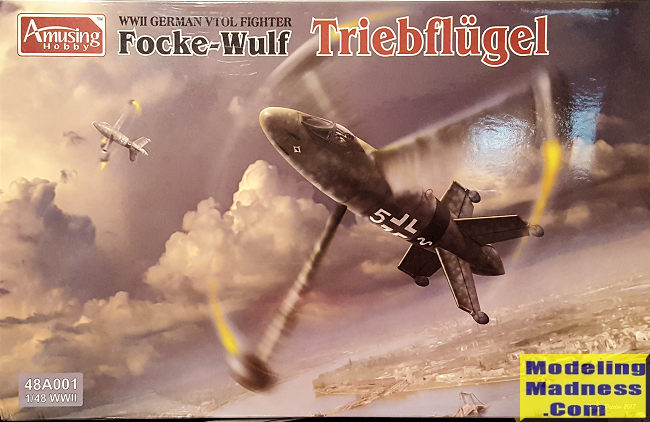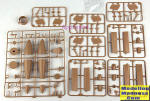
| KIT #: | 48A001 |
| PRICE: | $40-45.00 delivered |
| DECALS: | Multiple options |
| REVIEWER: | Scott Van Aken |
| NOTES: | New tool |

| HISTORY |
The design was particularly unusual. It had no wings, and all lift and thrust were provided by a rotor/propeller assembly 1/3 of the way down the side of the craft (roughly halfway between the cockpit and tailplane). When the plane was sitting on its tail in the vertical position, the rotors would have functioned similarly to a helicopter. When flying horizontally, they would function more like a giant propeller.
The three rotor blades were mounted on a ring assembly supported by bearings, allowing free rotation around the fuselage. At the end of each was a ramjet. To start the rotors spinning, simple rockets would have been used. As the speed increased, the flow of air would have been sufficient for the ramjets to work and the rockets would expire. The pitch of the blades could be varied with the effect of changing the speed and the lift produced. There was no reaction torque to cause a counter rotation of the fuselage, since the rotor blades were driven at their tips by the ramjets. Fuel was carried in the fuselage tanks, and was piped through the centre support ring and along the rotors to the jets.
A cruciform empennage at the rear of the fuselage comprised four tailplanes, fitted with moving ailerons that would also have functioned as combined rudders and elevators. The tailplane would have provided a means for the pilot to control a tendency of the fuselage to rotate in the same direction as the rotor, caused by the friction of the rotor ring, as well as controlling flight in pitch, roll and yaw.
A single large and sprung wheel in the extreme end of the fuselage provided the main undercarriage. Four small castoring wheels on extensible struts were placed at the end of each tailplane to steady the aircraft on the ground and allow it to be moved. The main and outrigger wheels were covered by streamlined clamshell doors when in flight.
When taking off, the rotors would be angled to give lift in a similar manner to a helicopter. Once the aircraft had attained sufficient altitude the pilot would tilt it over into level flight. The rotors continued spinning in level flight, maintaining 220 rpm at the aircraft's maximum forward speed.
Forward flight required a slight nose-up pitch to provide some upward lift as well as primarily forward thrust. Consequently, the four cannon in the forward fuselage would have been angled slightly downward in relation to the centreline of the fuselage.
To land, the craft had to slow its speed and pitch the fuselage until the craft was vertical. Power could then be reduced and it would descend until the landing gear rested on the ground. This would have been a tricky and probably dangerous maneuver, given that the pilot would be seated facing upward and the ground would be behind his head at this stage. Unlike some other tailsitter aircraft, the pilot's seat was fixed in the direction for forward flight. The spinning rotor would also obscure rear vision.
The aircraft was still in the planning stages and no prototype had been started.
| THE KIT |
 Many
years ago, Huma released this aircraft in 1/72 and it became a major seller for
them. Since there have been resin kits in 1/48 and recently a 1/35 offering from
Minicraft.
Many
years ago, Huma released this aircraft in 1/72 and it became a major seller for
them. Since there have been resin kits in 1/48 and recently a 1/35 offering from
Minicraft.
Amusing Hobby seems to make its business model developing kits of prototype or paper project vehicles having started by doing armor. This is apparently their first 1/48 aircraft if one can go by the part number.
The kit is actually fairly straight forward and the design of it is such that one gets multiple identical sprues for the rotor bits and the tail bits. The fuselage is on its own sprue. The tan plastic is very nicely molded and free from flash and obvious molding defects. You get a well appointed cockpit that really only needs a seat harness. The nose section is separate from the wing assembly and the rear fuselage. It is provided with a windscreen and canopy, but is shown in the closed position.
With that built, the rotating wing housing is built and attached. This is followed by the rear fuselage assembly minus fins, but with the main gear installed.
There are three identical sprues for the each two piece
wing/rotor and its five piece ramjet. These are then slotting into holes in the
wing base assembly. There are four identical sprues for the four fins with
auxiliary landing gear. These four smaller and the main gear have petal shaped
doors. These can be modeled closed,
 but you are
on your own when it comes to finding a display stand.
but you are
on your own when it comes to finding a display stand.
Instructions are well drawn but provide no color information. You can pretty well assume that the cockpit would be RLM 66 with perhaps RLM 02 landing gear struts. A fairly large decal sheet is included that provides a variety of insignia, unit badges, and numbers so you can make up your own. There is a large, fold out colors and markings sheet that offers some suggestions for splinter camouflage schemes. You can, of course, paint yours whatever way you might wish.
| CONCLUSIONS |
I am sure that Amusing Hobby will sell quite a few of these. Like AMtech's Ta-183, it is the sort of aircraft that strikes one's fancy and its rather open camouflage possibilities make it even that much more attractive.
| REFERENCES |
https://en.wikipedia.org/wiki/Focke-Wulf_Triebfl%C3%BCgel
September 2019
Copyright ModelingMadness.com. All rights reserved.
If you would like your product reviewed fairly and fairly quickly, please contact the editor or see other details in the Note to Contributors.
Back to the Main Page Back to the Review Index Page Back to the Previews Index Page